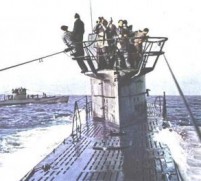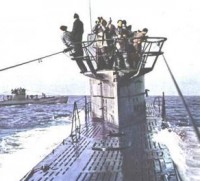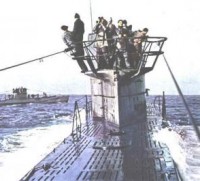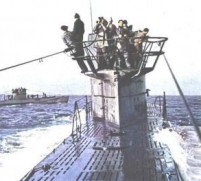U BOATS SUNK IN SOUTH ATLANTIC - U 128 / U 1062
54)U-1059 LAST PATROL
FIRST AND ONLY PATROL OF U-1059
DAMAGE TO 37-MM. GUN.
Soon after leaving Kiel on 4 February 1944 it was noticed that the 37-mm. gun was no longer in good order. A week before 100 practice rounds had been fired satisfactorily near Kiel, but apparently something had gone wrong during a dive.
CALL AT KRISTIANSAND.
U-1059 put into Kristiansand at about 0900 on 6 February and remained there until 9 February at 1400. Many hours were spent working on the 37 mm. but with unsatisfactory results.
CALL AT BERGEN.
The U-boat arrived in Bergen 10 February at 0800, remaining until 12 February at 1200. The 37 mm. was taken on shore, and the specialists there were able to complete the conditioning of the gun. One prisoner has expressed the opinion that this type of gun will never be reliable for undersea craft unless it can be made much sturdier and hence better able to withstand the effects of diving.
ARCTIC CIRCLE, FAROES, ROSENGARTEN.
From Bergen U-1059 set her course approximately 340° until a few miles north of the Arctic Circle. She then turned on course 220° to 230° through the area of the Rosengarten at one time close to the Faroes. For two or three days the weather was stormy, the temperature dropped to about 15° above zero Fahrenheit, and the bridge watches had an extremely difficult duty. Type VII-F
First and Only Patrol of U-1059
U-boats are said to be difficult to manage at best, and no less than two crew members of U-1059 had broken arms by the time of the sinking. During all this part of the patrol U-1059 proceeded at slow speed on the surface at night and at 1-1/2 to 2 knots submerged during the day. Several aircraft were sighted, although they were not picked up on the U-boats radar or search receiver.
SHIP SIGHTINGS.
A point thought to be roughly 52 N. - 24 W. the U-boat sighted late in February three fast ships traveling without escort. Contrary to her orders, U-1059 pursued the ships for a short time and wasted a little of her precious fuel. On another occasion the listening room personnel detected what they took to be a destroyer, but it was never sighted.
PAST THE AZORES.
In early March near the Azores, U-1059 had considerable trouble with her compressors. The Ju-compressor and E-compressor both failed, and when the emergency Ju-compressor was rigged up it also broke down. In all three there was a period of 4 days when the U-boat was unable to dive for lack of compressed air. Also in early March a message was intercepted from another U-boat nearby reporting a convoy west of the Azores. Another message about 16 March reported casualties and damage aboard a U-boat to the south of U-1059. (O.N.I. Note: This was U-801, sunk 17 March.)
In spite of this evidence of the need for caution, Leupold began to allow his men more and more to enjoy the fresh air on the bridge and upperdeck. His ship's doctor would usually be the one to suggest that the men needed something for their morale. Concerts were given on deck, there were several chess games, and on three occasions the crew members were allowed to swim near the boat. No less than 25 men were topside.
PRACTICE AIR ALERT.
On 18 March 1944, during next to the last swim, there was a practice air alarm. In the opinion of the survivors this did more harm than good, for when the gunfire alarm came the following morning, many valuable seconds were lost before it was taken seriously. U-1059 was then west of the Cape Verde Islands.
CHANGE OF COURSE.
Shortly before daybreak on 19 March the command was suddenly given to change course 160° to course 270°, much to the surprise of the crew members, who did not know they were to meet a supply U-boat in the area. They were four days ahead of schedule. After sailing due west a few miles, they stopped for the third and last swim.
SINKING OF U-1059
From U.S.S. BLOCK ISLAND report of 31 March 1944:
Task Group 21.16 had destroyed U-801 in latitude 16.42 N. - longitude 30.28 W. at 1325 on 17 March 1944, recovering the majority of its crew. Again the commander of the task group plotted the probable position of other subs in the suspected refueling area and search operations for the morning of the 19th were moved southwesterly in accordance. Within 10 minutes after sunrise, 19 March, at 0826Z, a TBF and an FM returning from the first leg of their early morning search, sixty miles south of the ship, sighted a fully surfaced submarine lying dead in the water, latitude 13.10 N. - longitude 33.44 W. The fighter pilot's impression was that it was a 740-tonner.
The fighter plane first strafed the surprised U-boat, with the TBF following to deliver a perfect depth-charge attack. Almost before the plumes had died down the fighter strafed again and this time reported seeing a bright flash aboard. Broken by the explosion, the sub sank stern first within a minute and a half. One minute later the TBF which had executed the kill spun into the water a half mile ahead of the submarine, while making a tight turn. The fighter pilot counted 15 to 116 survivors struggling in the oil and debris that marked the sinking. None of them had life belts. Alongside the spot where the plane had crashed, he saw a pilot in a life raft. A shark was circling in the area.
An hour and a half later relief planes could count only 8 survivors from the submarine. A couple of floating torpedoes had been sighted. U.S.S. CORRY arrived,lowered a boat to start picking up survivors, and scouted the area for sound contacts. She recovered one of the torpedoes and destroyed the other. Five Germans were found clinging to the wreckage or swimming in the middle of the oil slick where the sub had gone down. A nude body was floating nearby. The pilot of a relief TBF dropped his own liferaft near that of the wrecked pilot, who was joined by three Germans, including their commanding officer, Leupold. The position given by CORRY for the picking up of survivors was 13.14.1 N. - 33.26.9 W.
From interrogation of the 8 survivors:
The 3rd watch under the command of the quartermaster, Hartmann, had been on duty since 0600 German time. At about 0920 Hartmann announced throughout the boat that the sunrise was unusually beautiful, and a minute or two later the commanding officer, Leupold, issued permission for a 10-minute swim, but added, "Watch out for planes in this fine weather!" The engines were then stopped. Besides Leupold, those in the water included the 2nd watch officer, Karrasch, the chief engineer, Kamphausen, the doctor, Adomeit, and machinist's mate, Krietsch, who was even allowed to leave his duty in order to swim. In all, about 18 men were swimming.
At about 0930 German time Leupold shouted ,"Flieger!" ("Flyers!"). All the swimmers returned to the boat except one of the survivors, Bohnsack, who elected to swim away from the boat. The engineer officer and the doctor went below, and the 2nd watch officer, Karrasch, improved his chances for survival by remaining in the conning tower instead of helping the men who were manning the guns.
Both officer prisoners, Leupold and Karrasch, say that the engines were started and that the boat was moving by the time the first plane made a strafing attack, but other testimony is unanimous to the effect that no general alarm was sounded in the boat and that the machines were never started at all. The quartermaster was waiting for all the men to return to the boat, and he waited too long, for he himself was one of the first to be felled by the plane's bullets. Leupold too was severely wounded on the head and knee.
The second plane dropped two bombs, which the prisoners did not think could have been depth-charges, for one exploded aft on deck and the other scarcely below the surface on the starboard side, near the torpedo storage compartment. The U-boat returned fire but in no great volume. One drum (18 rounds) of 2-cm. shells was fired and one or two clips (5 rounds each) from the 37-mm. gun. A prisoner who served the latter gun is convinced that he hit and shot down the second plane. Fire broke out in one of the ready ammunition lockers, the whole boat seemed to crack, the stern settled quickly, and a few minutes later U-1059 was out of sight. Most of the survivors owe their lives to the fact that the explosions blew them clear of the boat.
An underwater explosion a few seconds after the disappearance of the boat was thought by two prisoners to be a battery explosion. There was no likelihood that scuttling charges were set off, and any torpedo explosion would have been much more violent. Oil pouring from the tanks made a hissing sound, and the large oil slick impeded swimming. One of the prisoners clung to a floating torpedo. Another, who had been clinging to the American pilot's raft, developed severe leg cramps after 2-1/2 hours and was about to give up when the destroyer appeared.

View from the front of the mid body (air tank) of a G7 torpedo recovered by USS Cory at the scene of the sinking of U-1059. Warhead section was attached there.

View from Aft of the mid body of a G7 a Torpedo.
By Jerry Mason USN Capt. Ret. www.uboatarchive.net



